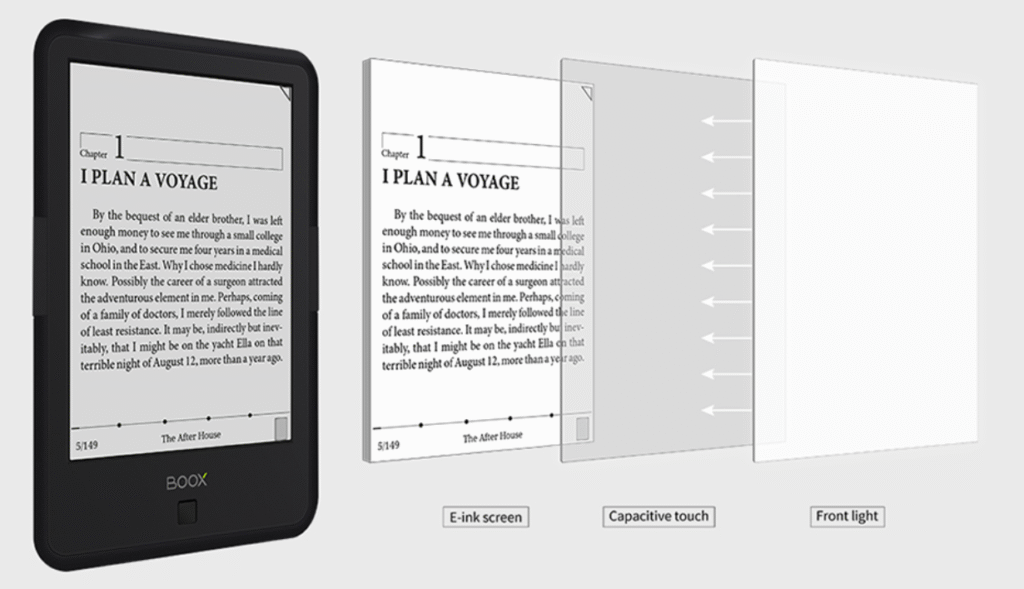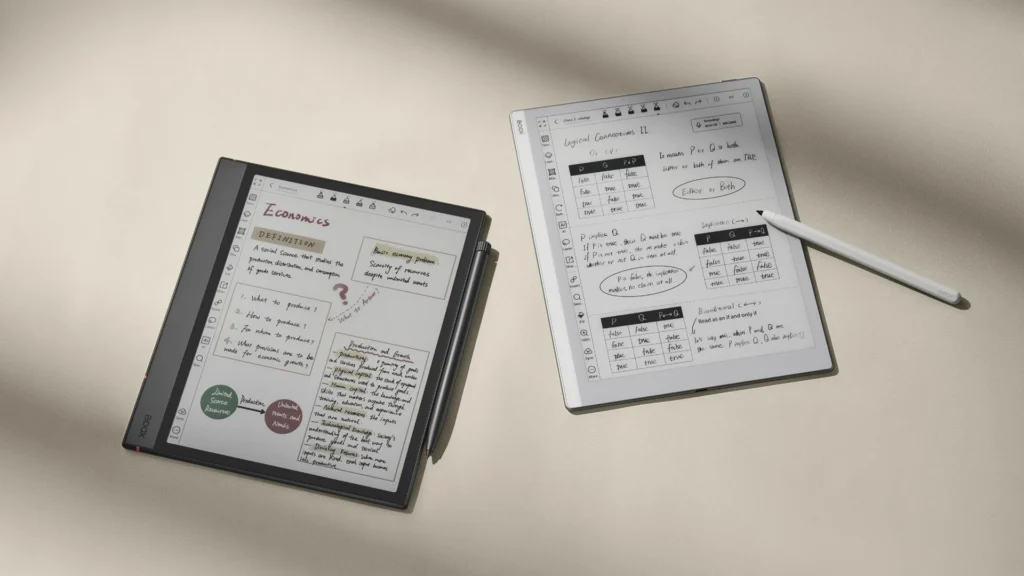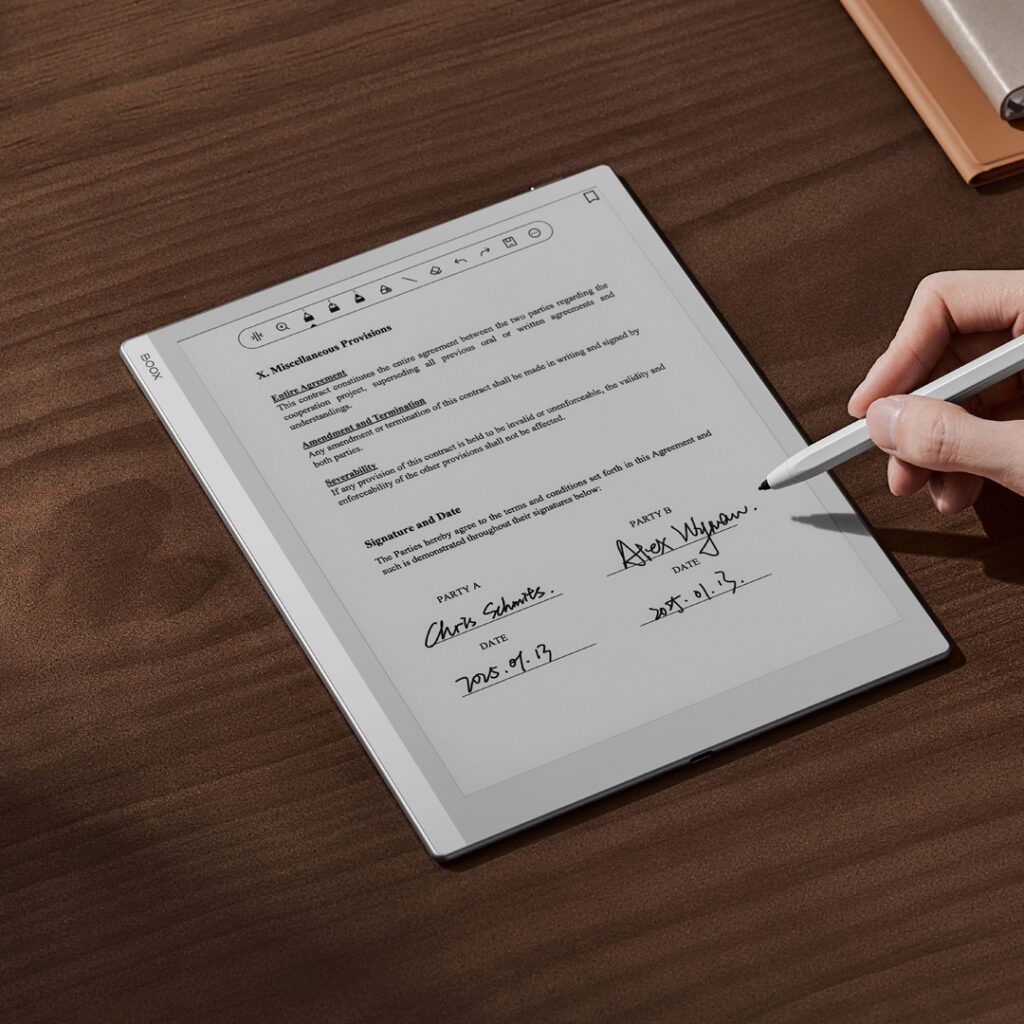If we compare E Ink vs. Paper, then E Ink is related to the specific brand and type of electronic paper display technology. It’s one of the most popular and widely used forms of ePaper. ePaper, in its turn, is used for the specification of any display, perfectly imitating traditional ink on paper.

What is ePaper?
ePaper is a display technology which was created to provide a paper-like reading experience even in conditions of bright light. The specific feature of ePaper is that it reflects ambient light, unlike conventional screens that emit their own light. The technology is not harmful to the eyes. There are a few key principles of ePaper work:
- Electrophoretic is the most common type, where text or images are formed by microscopic capsules, charged with black and white pigment particles.
- Electrofluidic is a type that uses electrically controlled colored ink. Low power usage is an additional benefit.
- Cholesteric LCD is a type where liquid crystals, which produce colors by reflecting specific wavelengths of light, are used. There is no need for a backlight.
ePaper is mostly used in such cases as e-readers, smart labels, and digital public information boards. The main priorities of it are readability and an energy-saving approach.
The Society for Information Display (2022) showcases that, in comparison to traditional LCD screens, ePaper can save 99% power.

What is E Ink?
E Ink is a trademarked electronic paper technology, which is the most widely used form of ePaper, developed by MIT Media Lab spin-off E Ink Corporation in 1997. It creates a user-friendly reading experience.
The basis of E Ink is electrophoretic technology, where text or images are formed by microscopic capsules, charged with black and white pigment particles. In order to create a text or image, the particles move up and down within the capsule under the influence of an electric field. Energy efficiency is an additional plus since the display holds the image without needing constant power after arrangement.
Among the most popular products should be mentioned Kindle Paperwhite, Kobo Clara, BOOX Note Air 4 C. Special highlight here is the fact that all E Ink displays are ePaper, but ePaper displays are more variable, and not all of them use E Ink.

ePaper vs E Ink — Key Differences
The comparison of E Paper vs. E Ink should start with the fact that ePaper technology offers a range of solutions for high-visibility and energy-efficient displays, where E Ink has a special place. The key features of the ePaper technology and E Ink brand are reflected in the table below.
Feature | ePaper (General) | E Ink (Brand) |
Scope | General category | Specific patented implementation |
Tech variants | Electrophoretic, electrofluidic, ChLCD | Electrophoretic only |
Color Availability | Monochrome & color (ACeP, ChLCD, others) | Monochrome & advanced E Ink Kaleido |
Power Consumption | Very low | Ultra-low, optimized for reading |
Market Presence | Broad range of brands | Dominates e-reader market |
E Ink has a dominant position due to its focus on readability and energy efficiency. Understanding the difference between ePaper vs. E Ink solutions can help to choose the right display type for the specific needs.
Which Technology Performs Better in Different Use Cases?
Different types of ePaper technology are suitable for certain applications. The most common real-world use cases, which reflect the performance of various technologies, are reflected below:
- Reading eBooks with E Ink is perfect as it creates a real paper experience with sharp text and high contrast, easy on the eyes during long reading sessions.
- Outdoor signage in sunlight is available with both E Ink and ChLCD ePaper, but ChLCD creates more colorful displays, clear outdoors.
- Digital note-taking, which feels natural, is available with E Ink combined with a Wacom layer (used in devices like BOOX and reMarkable).
- Retail price tags can be created with low-cost ePaper displays, which are energy-efficient.
The manufacturers get a perfect solution if they match the right ePaper technology to the specific needs.

Advantages and Limitations of Each
ePaper and E Ink displays have numerous advantages, which make them ideal for use. Still, there are some limitations if we compare them to some other display technologies.
Advantages of ePaper (General)
There are a few unique benefits of ePaper technology that set it apart from traditional display types like LCD or OLED, such as:
- A broad range of technology options, such as electrophoretic, cholesteric, and electrochromic displays.
- It can include color without filters by using colored pigments to create more natural-looking images.
These strengths make the popularity of ePaper grow.
Advantages of E Ink
As for the E Ink, it is the most widely adopted form of ePaper. The key benefits are as follows:
- Market dominance provides better ecosystem support, providing reliable products.
- Optimized for high readability and long battery life, consuming very little power.
Thanks to these advantages E Ink is a top energy-efficient and eye comfort solution.

Limitations
When choosing the right display technology, it’s important to understand the key limitations of E Ink vs. ePaper, such as:
- While considering ePaper, it’s important to know that not all variants have the same quality.
- As for E Ink, they are mostly grayscale since the color versions are less saturated.
Still, both technologies are strong choices for specific use cases.
The Evolution of Both Technologies
The development of ePaper began in the 1990s with early prototypes at Xerox PARC and MIT. The first E Ink-based e-readers, such as the Sony Librie and Amazon Kindle were presented in the 2000s. The 2010s–2020s were significant by flexible, color, and high-refresh-rate models. As for the future tendencies, it may be expected that the integration with IoT, foldable formats, and full-color reflective displays will occur.
Which One Should You Choose?
To sum up all of the above, those who are looking for an e-reader should pay attention to E Ink. However, there are some specific spheres, such as signage, labels, or specialized industrial uses, where other technologies should be taken into consideration. At Einktab, the consumers have access to a wide choice of options.

Frequently Asked Questions (FAQ)
1. Is ePaper bad for your eyes?
Study from Harvard School of Public Health states that ePaper is less harmful for the eyes than traditional LCD screens, so it should be the priority for people who care about their health.
2. Can ePaper display video?
ePaper displays are designed for static images. As a result, they can’t handle full-motion video.
3. How long do E Ink screens last?
E Ink screens are characterised by durability. In most cases, they last 5 to 10 years.
4. Is E Ink more expensive than other ePaper?
The prices of E Ink vs. ePaper vary depending on the specific type and features. In general, E Ink technology is more expensive than ePaper alternatives.



